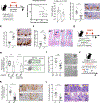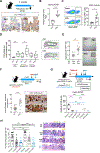Ketone Body Signaling Mediates Intestinal Stem Cell Homeostasis and Adaptation to Diet
- PMID: 31442404
- PMCID: PMC6732196
- DOI: 10.1016/j.cell.2019.07.048
Ketone Body Signaling Mediates Intestinal Stem Cell Homeostasis and Adaptation to Diet
Abstract
Little is known about how metabolites couple tissue-specific stem cell function with physiology. Here we show that, in the mammalian small intestine, the expression of Hmgcs2 (3-hydroxy-3-methylglutaryl-CoA synthetase 2), the gene encoding the rate-limiting enzyme in the production of ketone bodies, including beta-hydroxybutyrate (βOHB), distinguishes self-renewing Lgr5+ stem cells (ISCs) from differentiated cell types. Hmgcs2 loss depletes βOHB levels in Lgr5+ ISCs and skews their differentiation toward secretory cell fates, which can be rescued by exogenous βOHB and class I histone deacetylase (HDAC) inhibitor treatment. Mechanistically, βOHB acts by inhibiting HDACs to reinforce Notch signaling, instructing ISC self-renewal and lineage decisions. Notably, although a high-fat ketogenic diet elevates ISC function and post-injury regeneration through βOHB-mediated Notch signaling, a glucose-supplemented diet has the opposite effects. These findings reveal how control of βOHB-activated signaling in ISCs by diet helps to fine-tune stem cell adaptation in homeostasis and injury.
Keywords: HDAC; Hmgcs2; Intestinal stem cell; Notch; beta-hydroxybutyrate; ketogenic diet; ketone bodies.
Copyright © 2019 Elsevier Inc. All rights reserved.
Figures







References
-
- Arts J, King P, Marien A, Floren W, Belien A, Janssen L, Pilatte I, Roux B, Decrane L, Gilissen R, et al. (2009). JNJ-26481585, a novel “second-generation” oral histone deacetylase inhibitor, shows broad-spectrum preclinical antitumoral activity. Clin Cancer Res 15, 6841–6851. - PubMed
-
- Barker N, Ridgway RA, van Es JH, van de Wetering M, Begthel H, van den Born M, Danenberg E, Clarke AR, Sansom OJ, and Clevers H (2009). Crypt stem cells as the cells-of-origin of intestinal cancer. Nature 457, 608–611. - PubMed
Publication types
MeSH terms
Substances
Grants and funding
- R00 DK123407/DK/NIDDK NIH HHS/United States
- K99 DK123407/DK/NIDDK NIH HHS/United States
- P30 DK043351/DK/NIDDK NIH HHS/United States
- HHMI/Howard Hughes Medical Institute/United States
- R00 AG054760/AG/NIA NIH HHS/United States
- U54 CA163109/CA/NCI NIH HHS/United States
- T32 CA009216/CA/NCI NIH HHS/United States
- U54 CA224068/CA/NCI NIH HHS/United States
- K99 AG054760/AG/NIA NIH HHS/United States
- R01 CA207236/CA/NCI NIH HHS/United States
- R00 AG045144/AG/NIA NIH HHS/United States
- R01 CA034992/CA/NCI NIH HHS/United States
- R01 CA211184/CA/NCI NIH HHS/United States
LinkOut - more resources
Full Text Sources
Other Literature Sources
Medical
Molecular Biology Databases
Research Materials

